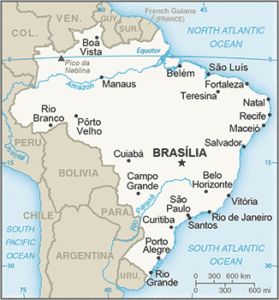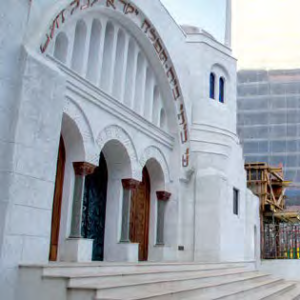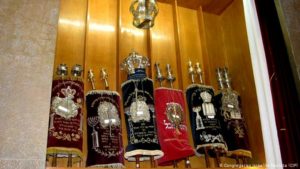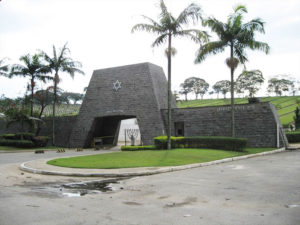 The Jewish presence in Brazil began as early as 1500, when Portuguese ships first brought Marranos to the land. However, Brazil’s 21 century Jewish community is mainly the result of an immigration wave that began in the 19th century and intensified during the 20th century, reaching its peak 1926-1942, when over 50,000 entered the country.
The Jewish presence in Brazil began as early as 1500, when Portuguese ships first brought Marranos to the land. However, Brazil’s 21 century Jewish community is mainly the result of an immigration wave that began in the 19th century and intensified during the 20th century, reaching its peak 1926-1942, when over 50,000 entered the country.
The first synagogue in Brazil, the Kahal Zur Israel, was built during the period of Dutch control (1630-1654). A second synagogue, Magen Abraham, had as its founding rabbi the Portuguese-Dutch Isaac Aboab da Fonseca (1605-1693), who arrived in Recife in 1641 and stayed for 13 years.
 However, in 1654 Brazil was reconquered by the Portuguese, and freedom of worship was revoked. In their treaty of surrender, the Dutch had required the Jews to be treated the same as other Dutch citizens: they had to leave within three months and would be allowed to sell their property and businesses. Jews only began returning to Brazil in 1822 when it became independent of Portugal. With the relative religious freedom granted by its Constitution of 1824, Jews began arriving in greater numbers in Rio de Janeiro, then the country’s capital.
However, in 1654 Brazil was reconquered by the Portuguese, and freedom of worship was revoked. In their treaty of surrender, the Dutch had required the Jews to be treated the same as other Dutch citizens: they had to leave within three months and would be allowed to sell their property and businesses. Jews only began returning to Brazil in 1822 when it became independent of Portugal. With the relative religious freedom granted by its Constitution of 1824, Jews began arriving in greater numbers in Rio de Janeiro, then the country’s capital.
 Jewish immigrants began arriving in Belém do Para, located in the Amazon region of Brazil, in 1810. The first to arrive were men who worked in riverside towns on the various tributaries of the Amazon River. These workers brought over their families. In 1824, the Belém Jewish community founded its first synagogue, Eshel Avraham, and in 1835 a second synagogue was built, Shaar Ha Shamaim. Around this time there were an
Jewish immigrants began arriving in Belém do Para, located in the Amazon region of Brazil, in 1810. The first to arrive were men who worked in riverside towns on the various tributaries of the Amazon River. These workers brought over their families. In 1824, the Belém Jewish community founded its first synagogue, Eshel Avraham, and in 1835 a second synagogue was built, Shaar Ha Shamaim. Around this time there were an
estimated 300 Jewish families living in the community. With the growth of the rubber industry between 1860 and 1910, an increased number of Moroccan Jews immigrated to Belém and Manaus. It is estimated that over 700 families were in the region.
 In 1904, a group of Jewish families from Bessarabia created the community of Philippson, in southern Brazil; in 1906 they opened Brazil’s first Jewish school. Jewish immigrants established the Quatro Irmãos (Four Brothers) colony in 1912; it eventually grew to more than 350 families and four settlements, each with its own school.By 1915 the population of Quatro Irmãos had grown to 1,600 people. Jewish immigrants from Eastern Europe settled Porto Alegre and Praça Onze from 1910 and set up synagogues and schools.
In 1904, a group of Jewish families from Bessarabia created the community of Philippson, in southern Brazil; in 1906 they opened Brazil’s first Jewish school. Jewish immigrants established the Quatro Irmãos (Four Brothers) colony in 1912; it eventually grew to more than 350 families and four settlements, each with its own school.By 1915 the population of Quatro Irmãos had grown to 1,600 people. Jewish immigrants from Eastern Europe settled Porto Alegre and Praça Onze from 1910 and set up synagogues and schools.
 After World War I (1914-1918), immigration intensified, and many new immigrants settled in Rio de Janeiro and São Paulo. In the 1930s, there was a wave of Jewish immigrants from Germany, and Syrian-Lebanese Jewish immigrants. During the late 1950s Jewish immigrants from Hungary, and French and Arabic-speaking immigrants from Egypt, Syria, Lebanon settled in Brazil. Lebanese and Syrian Jews also arrived during the 1970s.
After World War I (1914-1918), immigration intensified, and many new immigrants settled in Rio de Janeiro and São Paulo. In the 1930s, there was a wave of Jewish immigrants from Germany, and Syrian-Lebanese Jewish immigrants. During the late 1950s Jewish immigrants from Hungary, and French and Arabic-speaking immigrants from Egypt, Syria, Lebanon settled in Brazil. Lebanese and Syrian Jews also arrived during the 1970s.
The Jewish population of Brazil is around 120,000. The two largest Jewish communities are located in São Paulo (44,000) and Rio de Janeiro (22,000). In the Southern Region, Porto Alegre has a Jewish community of 7,000; the Northern Region is home to several smaller but historically older Jewish communities, including the very oldest, Belém do Pará (1,300), as well as Recife (1,300), and Manaus (1,200). Between 1948 and 2010, 11,586 Brazilian Jews emigrated to Israel.
 The site where the Kahal Zur Israel Synagogue once stood was excavated around the turn of the century. Archaeological investigations revealed the old building’s foundations as well as a ritual bath. The local Jewish community constructed a new building on the site, to be used both as a museum and cultural centre, as well as for religious purposes.
The site where the Kahal Zur Israel Synagogue once stood was excavated around the turn of the century. Archaeological investigations revealed the old building’s foundations as well as a ritual bath. The local Jewish community constructed a new building on the site, to be used both as a museum and cultural centre, as well as for religious purposes.
It completed and opened in 2001. Many Jews choose to celebrate their weddings and Bnei Mitzvot celebrations in the Kahal Zur Israel because of its symbolism as a connection to their long history in Brazil.